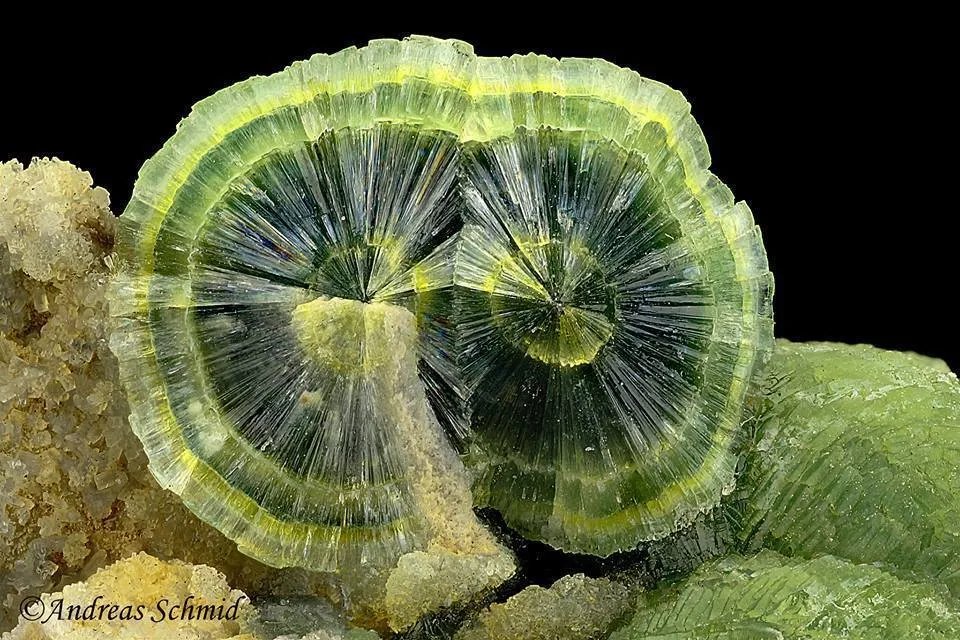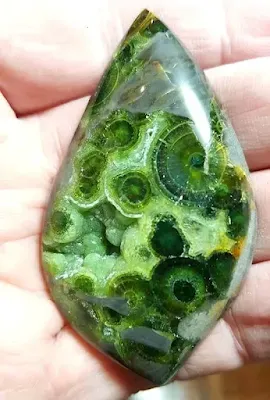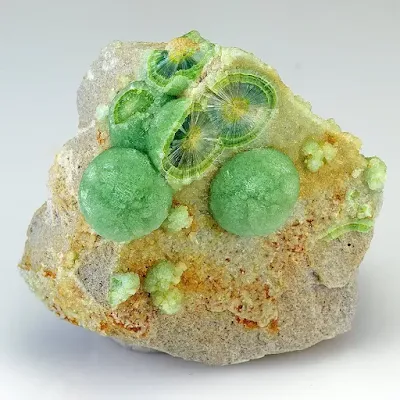Wavellite: Occurrence, Properties, Uses
Wavellite is a rare phosphate mineral known for its vibrant colors, unique crystal forms, and soft, waxy luster. It's a favorite among collectors and enthusiasts due to its fascinating properties and potential for stunning jewelry pieces.
Wavellite is a rare phosphate mineral that crystallizes into clusters, stalactites, needle-like crystals, or spherical structures.
Wavellite is an aluminium basic phosphate mineral, meaning it contains aluminum, phosphate, and hydroxide ions in its chemical formula Al₃(PO₄)₂(OH, F)₃·5H₂O. Wavellite is an aluminum basic phosphate, and is typically green, yellow, or brown in color.
When broken across the spheres, wavellite exhibits a radial crystalline structure - the local old timers call it "cats-eye". Color may vary from light to dark green at this locale, the intensity of the color is due to how much vanadium is present in the structure of the mineral.
Wavellite was first described in 1805 for an occurrence at High Down, Filleigh, Devon, England and named by William Babington in 1805 in honor of Dr. William Wavell (1750–1829), a Devon-based physician, botanist, historian, and naturalist, who brought the mineral to the attention of fellow mineralogists.
 |
| Green Radial Wavellite. From Mauldin Mt., Montgomery Co., Arkansas, USA Photo Credit: Andreas Schmid |
Wavellite Formation
Wavellite is categorized as a secondary mineral, meaning it doesn't originate directly from magma crystallization within igneous rocks. Instead, it arises through the alteration of primary minerals within pre-existing rocks. This transformation occurs via metamorphism, a process driven by changes in temperature, pressure, and/or chemical composition within the Earth's crust.
Wavellite preferentially forms in aluminum-rich, low-grade metamorphic rocks such as limonite. These rocks provide readily available aluminum phosphate, a key component for wavellite's crystal lattice structure. Additionally, hydrothermal veins and phosphate rock deposits can serve as suitable environments for wavellite precipitation due to the presence of mineral-rich fluids and conducive chemical conditions.
 |
| Wavellite - Fantastic Old Stock - Mauldin Mountain, Arkansas Photo credit: arkansasminerals.com |
Properties of Wavellite
Composition: Primarily composed of hydrated aluminum phosphate with hydroxide (OH) ions and water molecules. Chemical formula: Al₃(PO₄)₂(OH)₃·5H₂O
Color: Wavellite exhibits a beautiful range of colors, with green and yellow-green being the most common. However, it can also be found in white, yellow, brown, brownish-black, blue, and even colorless varieties. The color can be zoned or patchy within the same specimen.
Luster: The luster of wavellite varies depending on the specimen. It can be vitreous (glassy), greasy, pearly, or even resinous.
Crystal System: Wavellite crystallizes in the orthorhombic crystal system.
Streak: When scratched on an unglazed porcelain streak plate, wavellite leaves a white streak.
Hardness: Wavellite falls between 3.5 and 4 on the Mohs hardness scale, making it relatively soft and easily scratched.
Cleavage: Wavellite exhibits perfect cleavage on one direction and good cleavage on two others. This means it tends to break along specific planes when struck.
Crystal habit: Wavellite is most commonly found in radial or spherical aggregates of bladed or acicular crystals. These aggregates can form botryoidal, globular, or even stalactitic shapes.
Density: The density of wavellite is around 2.36 g/cm³.
Transparency: Wavellite is typically translucent to opaque, although some thin sections may allow light to pass through partially.
Fracture: When broken, wavellite exhibits an irregular or subconchoidal fracture.
Specific Gravity: The specific gravity of wavellite is slightly higher than its density, ranging from 2.35 to 2.37 g/cm³.
Solubility: Wavellite is soluble in acids, but it is insoluble in water.
Magnetism: Wavellite is not magnetic.
Fluorescence: Some wavellite specimens exhibit fluorescence under shortwave ultraviolet light, with colors ranging from yellow to green or blue.
Pleochroism: Wavellite can exhibit weak pleochroism, meaning its color can appear slightly different depending on the viewing angle.
Refractive Index: The refractive index of wavellite varies slightly depending on the specific color and composition. It typically ranges from 1.518 to 1.561.
Inclusions: Wavellite may contain inclusions of other minerals, such as quartz, pyrite, or limonite.
Associated Minerals are quartz, micas, turquoise and limonite.
Other Characteristics: surface of globules often have minute crystals giving off tiny sparkles.
Notable Occurances include Arkansas and Pennsylvania, USA; Bolivia and England.
Best Field Indicators are crystal habit, green color and softness.
Wavellite Uses
Wavellite's uses can be broadly categorized into three main areas: ornamental, scientific, and industrial.
Ornamental Uses:
Jewelry: Despite its softness, wavellite's captivating colors and unique forms make it a sought-after material for jewelry like pendants, earrings, and cabochons. Protective settings are crucial due to its low hardness.
Decorative objects: Wavellite's stunning natural beauty graces various decorative items like sculptures, carvings, and ornamental boxes.
Mineral collections: High-quality wavellite specimens are valuable additions to private and museum collections, showcasing the mineral's diversity and beauty.
Scientific Uses:
Research and education: Wavellite serves as a valuable tool for studying mineral properties, crystallography, and geological processes. Its unique structure and composition provide insights into mineral formation and environmental conditions.
Educational displays: Museums and educational institutions often exhibit wavellite specimens to educate the public about minerals and inspire curiosity about the natural world.
Industrial Uses:
Fertilizer production: Wavellite's aluminum phosphate content has potential applications in fertilizer production, potentially offering a sustainable alternative to traditional phosphate sources.
Fire retardants: Research suggests that wavellite's flame-retardant properties could be harnessed for development of eco-friendly fire-resistant materials.
 |
| Polished Wavellite cabochon, from Arkansas.
Photo: James Carpenter |
Where is Wavellite Found
It occurs in association with crandallite and variscite in fractures in aluminous metamorphic rock, in hydrothermal regions and in phosphate rock deposits. It is found in a wide variety of locations notably in the Mount Ida, Arkansas area in the Ouachita Mountains.
Wavellite is found in a variety of locations around the world, including:
North America:
Arkansas, USA: The Ouachita Mountains of Arkansas, particularly the Mount Ida region, are renowned for yielding some of the finest wavellite specimens in the world. These often come in stunning shades of green and yellow-green, with radial or spherical crystal habits.
Pennsylvania, USA: Chester County in Pennsylvania boasts deposits of wavellite, known for their pale green to white hues and radiating starburst patterns.
California, USA: California also has wavellite deposits, although they are less common compared to other locations.
Europe:
England, UK: The type locality of wavellite, High Down Quarry in Devon, England, still produces excellent wavellite specimens. These typically exhibit a green or yellow-green color and botryoidal formations.
Germany: Germany has several wavellite deposits, particularly in the Eifel and Harz regions. These often yield wavellite in various colors, including green, yellow, and brown.
Czech Republic: The Czech Republic also has wavellite deposits, known for their translucent to opaque green and brown specimens.
Other notable locations:
Morocco: Wavellite is found in a number of locations in Morocco, including the regions of Ouarzazate and Errachidia.
China: Wavellite is found in a number of locations in China, including the provinces of Hunan, Jiangxi, and Anhui.
Tasmania, Australia: This island state boasts wavellite deposits known for their pale green to white colors and radiating crystal structures.
Bolivia: Bolivia has wavellite deposits that produce specimens in a range of colors, including green, yellow, and blue.
Brazil: Wavellite can also be found in Brazil, with deposits yielding green and yellow-green specimens.
 |
| Wavellite from the Mauldin Mountain Quarries, Montgomery County, Arkansas Photo: Nunzio.j |
How to Care for Wavellite
Wavellite is a relatively soft mineral, so it should be handled with care. It should be stored in a cool, dry place. Wavellite can be cleaned with a soft brush and mild soap and water.
 |
| Black wavellite crystals |
See Also:
Where to Find Sunstone in Oregon?
Different Types and Colours of Moonstone
What Is Pseudomorph Mineral?









